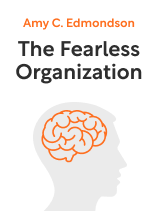

This article is an excerpt from the Shortform book guide to "The Fearless Organization" by Amy C. Edmondson. Shortform has the world's best summaries and analyses of books you should be reading.
Like this article? Sign up for a free trial here.
Does your company promote open communication? Do your employees have a voice at work?
In psychologically unsafe workplaces, employees will feel silenced and belittled. Amy C. Edmondson’s book The Fearless Organization explains how a culture of silence will eventually hurt the company down the line.
Continue reading to learn how silence in the workplace harms workers, leaders, and businesses.
Fear Leads to Silence, Which Hurts Companies
Edmondson says that in psychologically unsafe work cultures, employees don’t speak up out of fear that they, their ideas, and their concerns will be belittled, disregarded, or lead to retaliation. She says that people’s fear of being judged is so great that they engage in a process of “image management” every day, all day long, in which they monitor and censor what they say to avoid looking silly or stupid in front of others. This strategy keeps them safe so long as they say nothing, but once they open their mouths, people can accuse them of being stupid or incompetent again. Most people can’t handle this, so they stay silent to preserve their image.
(Shortform note: The culture Edmondson describes is defined by a lack of trust. In Carrots and Sticks Don’t Work, Paul Marciano says that although some people trust easily, it can take others years to develop trust and that one mistrustful step can destroy all that work. Therefore, you must work diligently to cultivate trust, which you can do by implementing a number of trust-building actionable steps, including 1) giving workers credit where it’s due instead of misattributing it; 2) keeping your word when you make promises; and 3) giving bad news to employees directly instead of allowing it to trickle down to them through the office grapevine.)
Edmondson says there are two big problems with silence in the workplace:
- They become disengaged and demonstrate low levels of creativity and productivity, which hinders organizations’ ability to innovate, grow, and perform.
- They don’t raise red flags that can help their organization ward off preventable problems and crises.
(Shortform note: As a leader, you might think you can encourage employees to share ideas, feedback, and concerns through anonymous surveys, but experts say this strategy can actually backfire for three reasons: 1) You’re communicating to employees that they can’t express their opinions openly and safely; 2) you risk setting off a witch hunt for people who provided negative feedback; 3) and it’s difficult to address issues raised without outing the person who raised them.)
Example: NASA’s Company Culture of Silence Led to Avoidable Disaster
In 2003, NASA engineer Rodney Rocha noticed something troubling on a grainy video of the shuttle Columbia following takeoff. Edmondson writes that when he brought concerns to higher-ups that he believed it was a loose chunk of foam that may have damaged the craft, his manager castigated him for engaging with people above his rank. At a subsequent meeting of senior managers where a discussion of the chunk of foam came up, Rocha kept his concerns to himself. Shortly thereafter, the foam caused the shuttle to explode, killing all seven astronauts aboard. When reporters asked Rocha why he didn’t push to let people at NASA know he’d found a potential problem, he responded that he “couldn’t” due to his low ranking.
Edmondson says Rocha’s silence and dilemma are the marks of a psychologically unsafe work climate that encourages silence in the workplace. Rocha felt unable to speak up, even though doing so could have prevented the catastrophe because his initial attempt earned him a reprimand. Edmondson says this is a common phenomenon in organizations with strict hierarchies, where leaders are siloed from frontline workers who can often provide critical information that would help the companies they work for ward off problems—and prevent them from becoming crises—before they happen.
Reviewing NASA’s Work Culture and Flawed Information-Sharing Practices
A 2003 review of NASA’s policies and protocols following the Columbia shuttle explosion by the Columbia Accident Investigation Board confirms Edmondson’s assessment that the internal culture at the organization at the time of the disaster didn’t support employees’ ability to speak up about potential safety issues. Despite managers confidently reporting that everyone at the agency was encouraged to voice their concerns, the Board found evidence contradicting their assertions, indicating that employees did submit safety concerns in emails that never reached the Mission Management Team.
The Board concluded that NASA’s bureaucratic, cost-efficiency-focused structure prevented critical information from reaching engineers and managers. Further, even as the Mission Management Team held lower-level engineers to rigid protocols, it failed to break its own bureaucratic stranglehold to address the challenge at hand in an unprecedented situation where lives were at risk.
The Board subsequently recommended that leadership focus on cultural changes to encourage frontline employees, in particular, to share valuable information—particularly that related to risk—to support NASA’s work and success.
A 2019 forum on lessons learned from the Columbia disaster highlighted additional areas for NASA to focus on to strengthen a culture that supports speaking up and information sharing within the agency: The Kennedy Space Center’s Manager of the Office of Diversity & Equal Opportunity noted that the Columbia investigation highlighted the importance of inclusion within the organization. He noted that inclusive practices create the opportunity for diverse voices to be heard, reducing the fear of repercussions for speaking up and ensuring that all relevant parties have the information they need to reduce risk and ensure safety.

———End of Preview———
Like what you just read? Read the rest of the world's best book summary and analysis of Amy C. Edmondson's "The Fearless Organization" at Shortform.
Here's what you'll find in our full The Fearless Organization summary:
- The importance of psychological safety in the workplace
- How leaders and non-leaders can foster psychologically safe environments
- Why workers should be able to make mistakes without fear of reprisal






